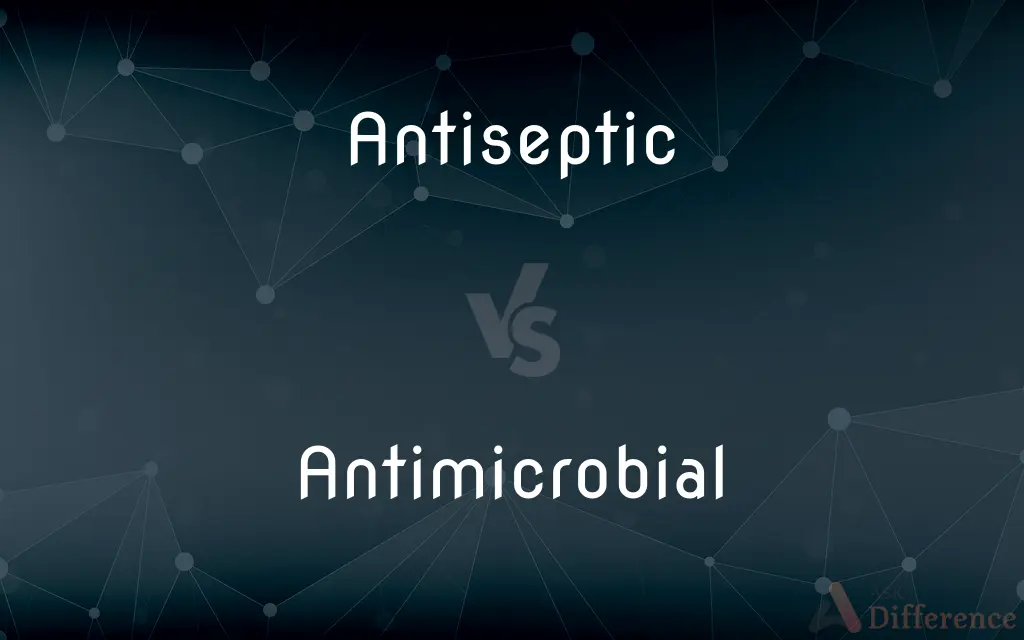Antiseptic vs. Antimicrobial — What's the Difference?
By Tayyaba Rehman & Fiza Rafique — Updated on March 13, 2024
Antiseptics are agents applied to living tissues to prevent infection, while antimicrobials kill or inhibit microbes on various surfaces, including living tissues.

Difference Between Antiseptic and Antimicrobial
Table of Contents
ADVERTISEMENT
Key Differences
Antiseptics are substances used on living tissues, such as skin or mucous membranes, to prevent infection by killing or inhibiting harmful microorganisms. In contrast, antimicrobials include a broader category of agents that can kill or inhibit the growth of microbes, including bacteria, viruses, fungi, and parasites, on both living and inanimate surfaces.
While antiseptics are primarily used for wound care, hand sanitization, and surgical preparations to ensure a sterile environment on the body, antimicrobials are used in a wide range of applications. These include not only medical and personal care products but also in agriculture, food preservation, and disinfectants for surfaces and materials.
The distinction between antiseptics and antimicrobials lies in their intended use and application scope. Antiseptics are specifically designed to be safe for application on living tissues, with formulations that minimize irritation or damage to cells. On the other hand, antimicrobial agents can be formulated to be potent against a wide range of organisms and may not always be suitable for direct application to the skin or mucous membranes due to their potential toxicity or side effects.
The effectiveness of antiseptics and antimicrobials depends on their concentration, the type of microorganism targeted, and the duration of exposure. For instance, certain antiseptics are more effective against bacteria, while others may also have antiviral or antifungal properties. Similarly, antimicrobials are selected based on the specific type of microbial contamination they are intended to combat, whether in healthcare settings, on agricultural products, or in household cleaning products.
Regulatory perspectives also differ, with antiseptics often subject to stringent safety and efficacy testing to ensure they are safe for use on humans. Antimicrobials, depending on their use (e.g., in healthcare, agriculture, or consumer goods), are regulated by different standards to ensure they effectively reduce or eliminate microbial threats without posing undue risk to humans, animals, or the environment.
ADVERTISEMENT
Comparison Chart
Definition
Substances applied to living tissues to prevent infection.
Agents that kill or inhibit microbes on various surfaces.
Application
Used on skin or mucous membranes.
Used on both living tissues and inanimate objects.
Purpose
Prevent infection in wounds, surgical sites.
Broad spectrum of microbial control.
Formulations
Designed to be safe for living tissues.
Potency varies; not all are suitable for living tissues.
Effectiveness
Depends on microorganism and exposure time.
Broad effectiveness against bacteria, viruses, fungi.
Regulatory Testing
Subject to safety and efficacy testing for human use.
Regulations vary by application (healthcare, agriculture, etc.).
Compare with Definitions
Antiseptic
Essential for maintaining sterile conditions on the body.
Antiseptic wipes are used to cleanse the skin before injections.
Antimicrobial
Can be selective or broad-spectrum in action.
Penicillin is an antimicrobial antibiotic that targets specific bacteria.
Antiseptic
Often formulated to minimize skin irritation.
Chlorhexidine is an antiseptic used in mouthwashes and skin cleansers.
Antimicrobial
Used across healthcare, agriculture, and consumer products.
Antimicrobial coatings are applied to medical devices to prevent infections.
Antiseptic
Agents preventing infection on living tissues.
Hydrogen peroxide is used as an antiseptic for minor cuts.
Antimicrobial
Agents that inhibit or kill microorganisms on various surfaces.
Bleach is an antimicrobial used to disinfect surfaces.
Antiseptic
Substances applied to the skin to kill microbes.
Alcohol-based hand sanitizers act as antiseptics to prevent disease spread.
Antimicrobial
Include substances targeting bacteria, viruses, and fungi.
Antimicrobial soaps contain agents that reduce microbial presence on hands.
Antiseptic
Used in surgical and wound care to prevent infections.
Iodine solutions are commonly used antiseptics before surgical procedures.
Antimicrobial
Regulated based on application and potential environmental impact.
Copper surfaces are used for their natural antimicrobial properties.
Antiseptic
An antiseptic (from Greek ἀντί anti, "against" and σηπτικός sēptikos, "putrefactive") is an antimicrobial substance or compound that is applied to living tissue/skin to reduce the possibility of infection, sepsis, or putrefaction. Antiseptics are generally distinguished from antibiotics by the latter's ability to safely destroy bacteria within the body, and from disinfectants, which destroy microorganisms found on non-living objects.Antibacterials include antiseptics that have the proven ability to act against bacteria.
Antimicrobial
An antimicrobial is an agent that kills microorganisms or stops their growth. Antimicrobial medicines can be grouped according to the microorganisms they act primarily against.
Antiseptic
Capable of preventing infection by inhibiting the growth of infectious agents.
Antimicrobial
Capable of destroying or inhibiting the growth of microorganisms
Antimicrobial hand sanitizers.
Antiseptic
Devoid of infectious agents; aseptic.
Antimicrobial
An antimicrobial drug.
Antiseptic
Of or associated with the use of antiseptics.
Antimicrobial
(pharmaceutical effect) tending to destroy or capable of destroying microbes
Antiseptic
Devoid of enlivening or enriching qualities
"This is ... not at all lighthearted or amiable music. In fact, the tone is unremittingly sober and antiseptic" (Donal Henahan).
Antimicrobial
(pharmaceutical effect) inhibiting the growth of microbes
Antiseptic
Free of disturbing or unpleasant features; sanitized
An antiseptic version of history.
Antimicrobial
(pharmaceutical effect) preventing or counteracting the pathogenic action of microbes
Antiseptic
A substance that prevents infection by inhibiting the growth of infectious agents.
Antimicrobial
An agent that destroys microbes, inhibits their growth, or prevents or counteracts their pathogenic action
Antiseptic
Of, or relating to antisepsis, or the use of antiseptics.
Antimicrobial
An agent (as heat or radiation or a chemical) that destroys microorganisms that might carry disease
Antiseptic
(pharmaceutical effect) Capable of preventing microbial infection.
Antimicrobial
Capable of destroying or inhibiting the growth of disease-causing microorganisms
Antiseptic
Very clean; aseptic.
Antiseptic
Free of unpleasantness; prim, sanitized or bowdlerized.
Antiseptic
(pharmaceutical drug) Any substance that inhibits the growth and reproduction of microorganisms. Generally includes only those that are used on living objects (as opposed to disinfectants) and aren't transported by the lymphatic system to destroy bacteria in the body (as opposed to antibiotics).
Antiseptic
Counteracting or preventing putrefaction, or a putrescent tendency in the system; antiputrefactive.
Antiseptic
A substance which kills or retards the growth of microorganisms, especially when used for protection against infection; a substance which prevents or retards putrefaction, or destroys, or protects from, putrefactive organisms; as, carbolic acid, alcohol, cinchona, and many other agents sold commercially.
Antiseptic
A substance that destroys micro-organisms that carry disease without harming body tissues
Antiseptic
Thoroughly clean and free of or destructive to disease-causing organisms;
Doctors in antiseptic green coats
The antiseptic effect of alcohol
It is said that marjoram has antiseptic qualities
Antiseptic
Clean and honest;
Antiseptic financial practices
Antiseptic
Freeing from error or corruption;
The antiseptic effect of sturdy criticism
Antiseptic
Made free from live bacteria or other microorganisms;
Sterilized instruments
Antiseptic
(extended sense) of exceptionally clean language;
Lyrics as antiseptic as Sunday School
Common Curiosities
Are antiseptics safe for all skin types?
While designed to be safe for living tissues, some individuals may experience sensitivity or allergic reactions to certain antiseptics.
What is an antiseptic?
Antiseptics are substances applied to living tissues to prevent infection by killing or inhibiting harmful microorganisms.
Can an antiseptic be an antimicrobial?
Yes, antiseptics are a subset of antimicrobials specifically formulated to be safe for use on living tissues.
What is an antimicrobial?
Antimicrobials are agents that can kill or inhibit the growth of microbes, including bacteria, viruses, fungi, and parasites, on both living and inanimate surfaces.
How do antiseptics differ from antimicrobials?
Antiseptics are intended for use on living tissues to prevent infection, while antimicrobials have a broader range of applications, including on inanimate objects.
How do antimicrobials work?
They work by disrupting the growth or survival mechanisms of microorganisms, effectively reducing or eliminating them.
How are antiseptics tested for efficacy?
They undergo rigorous safety and efficacy testing to ensure they effectively prevent infections without causing harm to living tissues.
What is the importance of antimicrobials in healthcare?
They are crucial for preventing and treating infections, controlling microbial growth, and ensuring sterile conditions in medical settings.
What are common uses of antiseptics?
Common uses include wound care, hand sanitization, and surgical preparations to prevent infections.
Where are antimicrobials used?
They are used in a wide range of settings, including medical and personal care products, agriculture, food preservation, and as disinfectants.
Can the overuse of antimicrobials lead to resistance?
Yes, overuse and misuse of antimicrobials can lead to the development of resistant strains of microorganisms.
Can antiseptics and antimicrobials be used together?
Yes, they can be used in conjunction, especially in medical and surgical settings, to ensure comprehensive microbial control.
Are there natural antiseptics and antimicrobials?
Yes, substances like honey and certain plant extracts have natural antiseptic and antimicrobial properties.
What role do antiseptics play in public health?
They are key in preventing the spread of infections, especially in healthcare settings and during outbreaks of infectious diseases.
How are antimicrobials regulated?
Regulations vary depending on their use, with stringent guidelines in healthcare and environmental considerations in agricultural applications.
Share Your Discovery

Previous Comparison
Mode vs. Modality
Next Comparison
Cyanide vs. NitrileAuthor Spotlight
Written by
Tayyaba RehmanTayyaba Rehman is a distinguished writer, currently serving as a primary contributor to askdifference.com. As a researcher in semantics and etymology, Tayyaba's passion for the complexity of languages and their distinctions has found a perfect home on the platform. Tayyaba delves into the intricacies of language, distinguishing between commonly confused words and phrases, thereby providing clarity for readers worldwide.
Co-written by
Fiza RafiqueFiza Rafique is a skilled content writer at AskDifference.com, where she meticulously refines and enhances written pieces. Drawing from her vast editorial expertise, Fiza ensures clarity, accuracy, and precision in every article. Passionate about language, she continually seeks to elevate the quality of content for readers worldwide.
















































